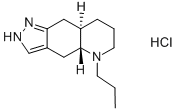(-)-QUINPIROLE HYDROCHLORIDE
Synonym(s):(-)-Quinpirole Hydrochloride - CAS 85798-08-9 - Calbiochem;(–)-Quinpirole monohydrochloride;trans-(–)-(4aR)-4,4a,5,6,7,8,8a,9-Octahydro-5-propyl-1H-pyrazolo[3,4-g]quinoline monohydrochloride;Dopamine D₂ Receptor Agonist, Quinpirole, Quinpirole, LY-171,555, LY 171555;LY-171,555
- CAS NO.:85798-08-9
- Empirical Formula: C13H22ClN3
- Molecular Weight: 255.79
- MDL number: MFCD00069336
- SAFETY DATA SHEET (SDS)
- Update Date: 2024-10-28 23:16:16

What is (-)-QUINPIROLE HYDROCHLORIDE?
The Uses of (-)-QUINPIROLE HYDROCHLORIDE
(-)-Quinpirole hydrochloride has been used as a selective D2 dopamine (DA) receptor agonist in various experiments.
The Uses of (-)-QUINPIROLE HYDROCHLORIDE
Antihypertensive.
What are the applications of Application
(?)-Quinpirole hydrochloride is a selective agonist of D2-like dopamine receptors
Biological Activity
(-)-quinpirole hydrochloride is an agonist of dopamine d2-like receptor [1].dopamine d2-like receptor reduces neuron’s excitability after activation by dopamine, making it an important drug target in schizophrenia and parkinson’s disease, but its ligands also cause cognitive inflexibility such as poor reversal learning [1, 2].in spiny neurons, (-)-quinpirole hydrochloride (5 ~ 10 μm) markedly reduced evoked firing in area x and lobus parolfactorius (lpo). unlike the enhancement of excitability by dopamine d1 receptor activation, the reduction in evoked firing by (-)-quinpirole hydrochloride was not voltage-dependent. this effect was antagonized by the dopamine d2-like receptor antagonist sulpiride (10 μm), which suggested that the effect of (-)-quinpirole hydrochloride was specific to dopamine d2-like receptor [2].in rats, (-)-quinpirole hydrochloride (0.01, 0.025, 0.1, 0.25, and 0.5 mg/kg) impaired both visual reversal learning task and spatial probabilistic reversal learning (prl) task in a dose-dependent manner. in analysis of the probe trials on the visual task, (-)-quinpirole hydrochloride at 0.25 mg/kg induced a complete blockade of learning from negative feedback, whilst learning from positive feedback was intact. estimated parameters from the model that best described the prl choice data revealed a steep and selective decrease in learning rate from losses [1].[1]. alsiö j, phillips b u, sala-bayo j, et al. dopamine d2-like receptor stimulation blocks negative feedback in visual and spatial reversal learning in the rat: behavioural and computational evidence. psychopharmacology (berl), 2019, 236(8): 2307-2323.[2]. ding l, perkel d j. dopamine modulates excitability of spiny neurons in the avian basal ganglia. the journal of neuroscience, 2002, 22(12): 5210-5218.
Biochem/physiol Actions
Quinpirole is a dopamine agonist with high affinity for the D2 and D3 dopamine receptor subtypes. Specific [3H]quinpirole binding in rat brain was saturable, and dependent on temperature, membrane concentration, sodium concentration and guanine nucleotides. The putative D2 dopamine receptor agonist quinpirole (LY 171,555) is the most widely used D2 agonist in in vivo and in vitro studies. Quinpirole hydrochloride is an active enantiomer of (±)-quinpirole.Saturation analysis revealed high affinity binding characteristics (KD = 2.3 +/- 0.3 nM) which were confirmed by association-dissociation kinetics. The regional distribution of [3H]quinpirole binding sites roughly paralleled the distribution of [3H]spiperone binding sites, with greatest densities present in the striatum, nucleus accumbens and olfactory tubercles. A variety of drugs, most notably monoamine oxidase inhibitors (MAOls), inhibit the binding of [3H]quinpirole, but not [3H]spiperone or [3H](-)N-n-Propylnorapomorphine, in rat striatal membranes by a mechanism that does not appear to involve the enzymatic activity of MAO. Clinically antidepressant MAOIs exhibited selectivity between sites labeled by [3H]quinpirole and [3H]spiperone as did a number of structurally related propargylamines and N-acylethylenediamine derivatives and other drugs such as debrisoquin and phenylbiguanide. The MAOIs clorgyline and Ro 41-1049 were the most potent. MAOIs interact with a novel binding site that is labeled by [3H]quinpirole or that modulates [3H]quinpirole binding. This site may be associated with D2-like dopamine receptors.
storage
Desiccate at -20°C
Properties of (-)-QUINPIROLE HYDROCHLORIDE
| storage temp. | -20°C |
| solubility | 0.1 M HCl: soluble23mg/mL |
| form | solid |
| color | white |
| optical activity | [α]25/D 124.5°, c = 0.4 in H2O(lit.) |
| Stability: | Hygroscopic |
Safety information for (-)-QUINPIROLE HYDROCHLORIDE
Computed Descriptors for (-)-QUINPIROLE HYDROCHLORIDE
New Products
4-AMINO-TETRAHYDRO-PYRAN-4-CARBOXYLIC ACID HCL 4-(Dimethylamino)tetrahydro-2H-pyran-4-carbonitrile 4-Aminotetrahydropyran-4-carbonitrile Hydrochloride (R)-3-Aminobutanenitrile Hydrochloride 3-((Dimethylamino)methyl)-5-methylhexan-2-one oxalate 1,4-Dioxa-8-azaspiro[4.5]decane 5-Bromo-2-nitropyridine Nimesulide BP Aceclofenac IP/BP/EP Diclofenac Sodium IP/BP/EP/USP Mefenamic Acid IP/BP/EP/USP Ornidazole IP Diclofenac Potassium THOMAIND PAPER PH 2.0 TO 4.5 1 BOX BUFFER CAPSULE PH 9.2 - 10 CAP SODIUM CHLORIDE 0.1N CVS ALLOXAN MONOHYDRATE 98% PLATINUM 0.5% ON 3 MM ALUMINA PELLETS (TYPE 73) LITHIUM AAS SOLUTION 2-Bromo-1-(bromomethyl)-3-chloro-5-nitrobenzene 2-Bromo-3-nitroaniline N-(3-Hydroxypropyl)-N-methylacetamide 3-Bromo-6-chloropyridazine 4-ethyl-3-nitrobenzoic acidRelated products of tetrahydrofuran
You may like
-
 (−)-Quinpirole hydrochloride CAS 85798-08-9View Details
(−)-Quinpirole hydrochloride CAS 85798-08-9View Details
85798-08-9 -
 1-Methyl-6-oxo-1,6-dihydropyridazine-3-carbonitrile 98%View Details
1-Methyl-6-oxo-1,6-dihydropyridazine-3-carbonitrile 98%View Details
99903-60-3 -
 1823368-42-8 98%View Details
1823368-42-8 98%View Details
1823368-42-8 -
 2-(3-(tert-butyl)phenoxy)-2-methylpropanoic acid 1307449-08-6 98%View Details
2-(3-(tert-butyl)phenoxy)-2-methylpropanoic acid 1307449-08-6 98%View Details
1307449-08-6 -
 Ethyl 3-(furan-2-yl)-3-hydroxypropanoate 25408-95-1 98%View Details
Ethyl 3-(furan-2-yl)-3-hydroxypropanoate 25408-95-1 98%View Details
25408-95-1 -
 2-Chloro-5-fluoro-1-methoxy-3-methylbenzene 98%View Details
2-Chloro-5-fluoro-1-methoxy-3-methylbenzene 98%View Details
1805639-70-6 -
 1784294-80-9 98%View Details
1784294-80-9 98%View Details
1784294-80-9 -
 Lithium ClavulanateView Details
Lithium ClavulanateView Details
61177-44-4

